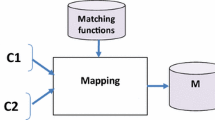Abstract
Determining the grade of semantic similarity between geospatial concepts is the basis for evaluating semantic interoperability of geographic information services and their users. Geometrical models, such as conceptual spaces, offer one way of representing geospatial concepts, which are modelled as n-dimensional regions. Previous approaches have suggested to measure semantic similarity between concepts based on their approximation by single points. This paper presents a way to measure semantic similarity between conceptual regions—leading to more accurate results. In addition, it allows for asymmetries by measuring directed similarities. Examples from the geospatial domain illustrate the similarity measure and demonstrate its plausibility.
Preview
Unable to display preview. Download preview PDF.
Similar content being viewed by others
References
Gärdenfors, P.: Conceptual Spaces: The Geometry of Thought, 317 pp. MIT Press, Cambridge (2000)
Lakoff, G.: Cognitive Semantics. In: Eco, U., Santambrogio, M., Violi, P. (eds.) Meaning and Mental Representations (Advances in Semiotics), pp. 119–154. Indiana University Press, Bloomington (1988)
Barsalou, L.: Situated simulation in the human conceptual system. Language and Cognitive Processes 5(6), 513–562 (2003)
Gärdenfors, P.: Representing actions and functional properties in conceptual spaces. In: Ziemke, T., Zlatev, J. (eds.) Body, Language and Mind (2004) (to appear)
Raubal, M.: Formalizing Conceptual Spaces. In: Varzi, A., Vieu, L. (eds.) Formal Ontology in Information Systems, Proceedings of the Third International Conference (FOIS 2004), pp. 153–164. IOS Press, Amsterdam (2004)
Devore, J., Peck, R.: Statistics - The Exploration and Analysis of Data. In: Pacific Grove, 4th edn., 713 pp. Pacific Grove, CA (2001)
Jones, W.P., Furnas, G.W.: Pictures of Relevance: A Geometric Analysis of Similarity Measures. Journal of American Society for Information Science 38(6), 420–442 (1987)
Suppes, P., et al.: Foundations of Measurement. In: Geometrical, Threshold, and Probabilistic Representations, vol. 2, p. 493. Academic Press, Inc., San Diego (1989)
Attneave, F.: Dimensions of Similarity. American Journal of Psychology 63, 516–556 (1950)
Melara, R.D., Marks, L.E., Lesko, K.E.: Optional processes in similarity judgments. Perception & Psychophysics 51(2), 123–133 (1992)
Johannesson, M.: Combining Integral and Separable Subspaces. In: Twenty-Third Annual Conference of the Cognitive Science Society. Lawrence Erlbaum, Mahwah (2001)
Johannesson, M.: The Problem of Combining Integral and Separable Dimensions, 16 pp. Lund University Cognitive Studies, Lund (2002)
Johannesson, M.: Geometric Models of Similarity. Lund University Cognitive Studies, vol. 90, 171 pp. Lund University, Lund (2002)
Pike, W., Gahegan, M.: Constructing Semantically Scalable Cognitve Spaces. In: Kuhn, W., Worboys, M.F., Timpf, S. (eds.) COSIT 2003. LNCS, vol. 2825, pp. 332–348. Springer, Heidelberg (2003)
Tversky, A., Sattath, S.: Additive Similaritiy Trees. Psychometrika 42(3), 319–345 (1977)
Rodríguez, A., Egenhofer, M.: Determining Semantic Similarity Among Entity Classes from Different Ontologies. IEEE Transactions on Knowledge and Data Engineering 15(2), 442–456 (2003)
Rodríguez, A., Egenhofer, M.J.: Comparing Geospatial Entity Classes: An Asymmetric and Context-Dependent Similarity Measure. International Journal of Geographical Information Science 18(3), 229–256 (2004)
Rada, R., et al.: Development and application of a metric on semantic nets. IEEE Transactions on systems, man, and cybernetics 19(1), 17–30 (1989)
Hahn, U., Chater, N., Richardson, L.B.: Similarity as transformation. Cognition 87, 1–32 (2003)
Rosch, E.: Principles of Categorization. In: Rosch, E., Lloyd, B. (eds.) Cognition and Categorization, pp. 27–48. Lawrence Erlbaum Associates, Hillsdale (1978)
Goldstone, R.L., Kersten, A.: Concepts and Categorization. In: Healy, A.F., Proctor, R.W. (eds.) Comprehensive Handbook of Psychology, pp. 599–621. Wiley, New Jersey (2003)
Tversky, A.: Features of Similarity. Psychological Review 84(4), 327–352 (1977)
Tversky, A., Gati, I.: Studies of Similarity. In: Rosch, E., Lloyd, B. (eds.) Cognition and Categorization, pp. 79–98. Lawrence Erlbaum, Hillsdale (1978)
Tversky, A., Gati, I.: Similarity, Separability, and the Triangle Inequality. Psychological Review 89(2), 123–154 (1982)
Johannesson, M.: Modelling Asymmetric Similarity with Prominence. British Journal of Mathematical and Statistical Psychology 53, 121–139 (2000)
Krumhansl, C.L.: Concerning the Applicability of Geometric Models to Similarity Data: The Interrelationship Between Similarity and Spatial Density. Psychological Review 85(5), 445–463 (1978)
Rodríguez, A., Egenhofer, M., Rugg, R.D.: Assessing Semantic Similarities Among Geospatial Feature Class Definitions. In: Včkovski, A., Brassel, K.E., Schek, H.-J. (eds.) INTEROP 1999. LNCS, vol. 1580, pp. 189–202. Springer, Heidelberg (1999)
Rodríguez, A.: Assessing Semantic Similarity Among Spatial Entity Classes, in Spatial Information Science and Engineering. PhD Thesis. University of Maine: Maine, 168 pp. (2000)
Egenhofer, M., Franzosa, R.: Point-set topological spatial relations. International Journal of Geographical Information Systems 5(2), 161–174 (1991)
Egenhofer, M.J.: A Formal Definition of Binary Topological Relationships. In: Litwin, W., Schek, H. (eds.) Third International Conference on Foundations of Data Organization and Algorithms (FODO), pp. 457–472. Springer, Paris (1998)
Goodman, J.E., O’Rourke, J.: Handbook of Discrete and Computational Geometry. In: Discrete Mathematics and Its Applications, 1st edn. CRC Press, Boca Raton (1997)
de Berg, M., et al.: Computational Geometry - Algorithms and Applications, vol. 1, 365 pp. Springer, Berlin (1977)
Author information
Authors and Affiliations
Editor information
Editors and Affiliations
Rights and permissions
Copyright information
© 2005 Springer-Verlag Berlin Heidelberg
About this paper
Cite this paper
Schwering, A., Raubal, M. (2005). Measuring Semantic Similarity Between Geospatial Conceptual Regions. In: Rodríguez, M.A., Cruz, I., Levashkin, S., Egenhofer, M.J. (eds) GeoSpatial Semantics. GeoS 2005. Lecture Notes in Computer Science, vol 3799. Springer, Berlin, Heidelberg. https://doi.org/10.1007/11586180_7
Download citation
DOI: https://doi.org/10.1007/11586180_7
Publisher Name: Springer, Berlin, Heidelberg
Print ISBN: 978-3-540-30288-9
Online ISBN: 978-3-540-32283-2
eBook Packages: Computer ScienceComputer Science (R0)




